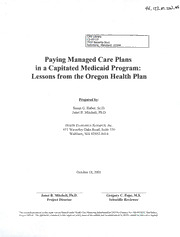Table Of ContentCMSLibrary
C2-07-13
7500SecurityBlvd.
Baltimore, Maryland 21244
Paying Managed Care Plans
in a Capitated Medicaid Program:
Lessons from the Oregon Health Plan
Preparedby:
SusanG.Haber,Sc.D.
JanetB.Mitchell,Ph.D
HealthEconomicsResearch,Inc.
411WWaavletrhlaemy,OMaAks0R2o4a5d2,-8Su4i1t4e330
October18,2001
JanetB.MitcheU,Ph.D. GregoryC.Pope,M.S.
ProjectDirector ScientificReviewer
TheresearchpresentedinthisrepotwasperformedunderHealhCareFinancingAdministration(HCFA)ContractNo.500-94-0056,PaulBoben,
ProjectOfficer.ThestatencntscontainedinthisrepotaresolelythoseoftheauthorsandnoendorsementbyHCFAshouldbeinferredorimplied.
TableofContents
Page
Introduction -1-
RateSettingMethodology -4-
RateCategories -4-
DataUsedtoSetRates -10-
SettingCapitationRates -15-
AltemativestoRateSetting -18-
CapitationRateTrends -19-
RiskAdjustment -30-
LessonsLearned -33-
References R-1
HealthEconomicsResearch,Inc. EvaluationoftheOregonMedicaidDemonstration: i
Oreg\raiesettiiig\TOC.WPD\mb DRAFT
TableofTables,FiguresandExhibits
Page
Exhibit1 OHPRateCategories -5-
Figure1 OHPGeographicPaymentAreas -9-
Table1 StatewideAverageFCHPMonthlyCapitationRatebyEligibiUtyGroup,
1994-1999 , -21-
Table2 PercentChangeinStatewideFCHPMonthlyCapitationRateby
EligibilityGroup,1994-1999 -23-
TableS AverageSF-12HealthStatusScoresbyEligibilityGroup -25-
Table4 FCHPMonthlyCapitationRateasaPercentofStatewideAverage,
1994-1997 -29-
TableS RiskAdjustmentScoresAppliedtoOctober1998CapitationRates ... -34-
HealthEconomicsResearch,Inc. EvaluationoftlieOregonMedicaidDemonstration: ii
Oregtateselting>TOC.WPD\mb DRAFT
I
PayingManagedCarePlansinaCapitatedMedicaid
Program:LessonsfromtheOregonHealthPlan
Introduction
State Medicaid programs are increasingly enrolling Medicaid beneficiaries in
managedcareplanswiththegoalofcontrollingprogramcosts,whileimprovingaccessto
servicesandqualityofcare. AcrucialpolicyquestionforstatesthatimplementaMedicaid
managedcareprogramishowtosetthecapitationratesforthemanagedcareplanswith
whichtheycontract. Manystatesuseanadministeredpricingsystem,wherebythestatesets
capitationratesthatanyplanwishingtoparticipateintheprogrammustagreetoaccept.
Otherstatesuseacompetitivebiddingsystem,inwhichcapitationpaymentsarebasedon
planoffersofratesatwhichtheywillprovideservicestotheirenrolledpopulations. The
statethendecideswhichoftherateoffersitiswillingtoaccept. Stillothersnegotiaterates
withplans. Regardlessofwhetherastateusesadministeredpricing,competitivebidding,
ornegotiatedrates,thereareseveralkeyquestionsthatmustbeaddressedwhensetting
paymentsorevaluatingofferingsfiromplans. Theseinclude:
• Howshouldratecategoriesbedefined?
• Whatdatasourcesshouldbeusedtosetratesorevaluaterateofferings?
• Howshouldutilizationderivedfi-omthesedatasourcesbeadjustedwhen
settingratesorevaluatingplanofferings?
• DoratesettingmethodsneedtobemodifiedasaMedicaidmanagedcare
programagesandanincreasingproportionofthepopulationisenrolled
inmanagedcare?
• Shouldpaymentratestoplansvaryinordertoaccountforenrollmentof
populationswithdifferingriskcharacteristics?
HealthEconomicsResearch,Inc. EvaluationoftheOregonMedicaidDemonstration: 1
Oreg^TateseItmg\altext.wpd\inb
Thisreportdescribesexperiencewithsettingcapitationratesduringthefirstsixyears
oftheOregonHealthPlan(OHP),Oregon'sSection1115Medicaidwaiverprogram. OH?
beneficiariesinnearlyeveryeligibilitycategoryarerequiredtoenrollinacapitatedmanaged
careplaninallareasoftheStatewherecontractingplansareavailable.' Inareaswithouta
planorwherecapacityisinadequatetoservetheentireOHPpopulation,beneficiariesare
enrolledinprimarycarecasemanagementor,whennecessary,remainintraditionalfee-for-
service. OtherimportantinnovationsadoptedaspartofOHPincludetheuseofaprioritized
listofmedicalconditionsandtreatmentstodefinethebenefitpackageandexpanding
Medicaideligibilitytoincludeallresidentswithincomesbelow100percentoftheFederal
PovertyLevel(FPL).
AsofApril2000,OHPcontractedwithfiillycapitatedhealthplans(FCHPs)to
providephysicalhealthservicesinallbut4ofOregon's36counties. FCHPscoverafiiU
rangeofacuteservices.^Managedcareplansreceiveamonthly^capitationpaymentforeach
enroUee''thatvariesbyratecategoryandgeographicarea. Oregonusesanadministered
pricingsystem. TheState'sactuarialconsultant^setsthecapitationratesandOregon
Certainbeneficiariesareexemptfrommanagedcareenrollment,includingMedicaredualeligibleswhoareenrolled
inaMedicare4-ChoiceplanthatdoesnotcontractwithOHP,NativeAmericans,womenwhobecomeeligibleduring
thethirdtrimesteroftheirpregnancies,andotherindividualsforwhommanagedcareenrollmentwouldcreate
accessbarriersorwoulddisruptcontinuityofcare.
^ Separatemanagedcareplanscoverdentalandmentalhealthservices.
' OInHitPialblye,gannewwemeekmlbyeernsrowlelrmeenotnloyfebennreoflilceidariinesa.maPnlaangserdecceairveepplraon-orantetdhecafipristtadtiaoynopfatyhmeemnotnstfho.rmIenmJbaenurasrytha1t99a7r,e
notenrolledforafiillmonth.
* Unlikecommercialinsurance,Medicaidprogramstypicallymakeseparatecapitationpaymentsforeach
memberofafamilyenrolledinaplan.
' PricewaterhouseCoopers,formerlyCoopersandLybrand.
HealthEconomicsResearch,Inc. EvaluationoftheOregonMedicaidDemonstration: 2
Oreg\raiesening\altext.wpd\mb
contractswithanyplanwillingtoacceptthepaymentamountsandthatmeetscontracting
standardsinareassuchasaccess,financialsolvency,andqualityassuranceactivities.
ThemethodsusedtosetratesinOHPhaveevolvedconsiderablyoverthelifeofthe
program. Thenumberofratecategorieshasexpandedfi-om9to16inresponsetoprogram
eligibilitychanges,aswellassubstantialutilizationdifferencesacrosssubgroupswithinrate
categories. Settingcapitationratesforeligibilitygroupswithwhichtherewaslittleorno
priorexperience,suchastheexpansionpopulations,hasprovenparticularlychallenging.
Initially,capitationrateswerebasedonpre-OHPclaimsdata. However,astheprogramhas
aged,thesedatabecameincreasinglyout-of-dateandOregonhasbegunusingencounterdata
instead. Nonetheless,usingencounterdatamaybeproblematicbecauseofconcernsabout
theircompletenessandaccuracy. Thepossibilitythatplanswillenrollpopulationswith
differingriskcharacteristicsposesseriouschallengesforsettingequitablereimbursement
ratesundercapitatedprograms. OHP,whichbeganriskadjustingcapitationpaymentsfor
selectedratecategoriesduringits fifthyearofoperation, isoneofthefirststatesto
implementriskadjustmentforaMedicaidpopulation.
ManyofthechangesinOregon'sratesettingmethodsoverthecourseoftheprogram
addressissuesthatwillbefacedbyotherstatesenrollingasubstantialportionoftheir
Medicaidpopulationinmanagedcare. Theremainderofthisreportisorganizedasfollows.
WebeginwithadescriptionofOHP'sratecategoriesandthemethodsusedtoestablish
capitationrates.Wethenlookattrendsincapitationpaymentsovertime,aswellasvariation
byregionoftheState. Thefollowingsectiondescribesmethodsthathavebeenusedtorisk
adjustpaymentrates. ThereportconcludeswithadiscussionoflessonslearnedfromOHP's
experienceswithratesetting.
HealthEconomicsResearch,Inc. EvaluationoftheOregonMedicaidDemonstration:3
Oreg\ratesetting\alIexl.wpd'inb
RateSettingMethodology
RateCategories
Ideally,ratecategoriesshouldcapturegroupsofbeneficiariesthatarerelatively
homogeneouswithrespecttoexpectedcost. Ifthereisnon-randomvariationwithingroups,
plansmaybeabletoidentifylower-costbeneficiariesandselectivelyenrollthem. While
definingratecategoriesmorefinelycanreduceopportunitiesforriskselection,thereare
limitstothenumberofcategoriesthatarefeasible. First,agreaternumberofcategories
increasethecomplexityofadministeringaprogram. Second,costestimatesmaynotbe
stableifthereareaninsufficientnumberofbeneficiariesinagivencategory. Third,ifrate
categoriesarenotexogenous(i.e.,arebasedonfactorssuchasdiagnosisoruseofparticular
typesofservice),havingmorecategoriesincreasesthepossibilitiesforproviderstogamethe
classificationsystem. Thus,thereisatrade-offbetweenminimizingpotentialforselection
biasandadministrativefeasibility.
Overtime,OHPhasincreasinglydisaggregateditsratecategories. Initially,four
categorieswereestablishedforthePhase1populationandfiveforthePhase2population.^
ThesecategoriesareshowninExhibit1. ThebulkofthePhase1populationwascovered
bytheOHPbasiccategory,whichincludedallPhase1beneficiarieswithincomesbelow
FPLexcepttheGeneralAssistance(GA)population. Alongwithseveralcategoriesof
traditionalMedicaideligibles,OHPbasicincludedthetwoexpansionpopulationgroups.
Theeligibilitygroupsthatcomprisedthebasicratecategorywere:
' bPrhoausgeht1oinfOtoHOPHbPeguanndeirnPFheabsreua2r.y1994.InJanuary1995,theaged,blind,disabled,andchildreninfostercarewere
HealthEconomicsResearch,Inc. EvaluationoftheOregonMedicaidDemonstration:4
OTeg\ratesetting\altext.wpd^b
Exhibit1
OHPRateCategories
Effective2/94through9/97 Effective10/97 Effective7/98
PhaseI PhaseI PhaseI
"tanf TANF
OHPBasic PPLLMMPChrielgdnraenntbWoommeafnte<r1100/01/%83FP<L100%FPL PPLLMMaPrnedgSnaCnHtIWPoCmhielndr<en160-01%8FPL
NewFamilies NewFamilies
_NewAdults/Couples NewAdults/Couples
PLMPregnantWomen100-133%FPL PLMPregnantWomen100-133%FPL PLMPregnantWomen100-170%FPL
PLMChildren<6100-133%FPL PLMChildren<6100-133%FPL ~PSCLHMIPChCihlidl<d<11
_PLMandSCHIPChild1-5
GeneralAssistance GeneralAssistance GeneralAssistance
Phase2 Phase2 Phase2
AgedwithMedicare AgedwithMedicarePartA&B/PartAonly AgedwithMedicarePartA&B/PartAonly
AgedwithoutMedicare _AAggeeddwwiitthhoMuetdMiecdairceaPraertBonly' AAggeeddwwiitthhoMuetdMiecdairceaPraertBonly'
BlindandDisabledwithMedicare BlindandDisabledwithMedicare BlmdandDisabledwithMedicare
BlindandDisabledwithoutMedicare BlindandDisabledwithoutMedicare BlindandDisabledwithoutMedicare
ChildreninFosterCare ChildreninFosterCare ChildreninFosterCare
'AseparatecategoryforagedbeneficiarieswithMedicaidPartBwentintoeffectinMarch1997.
• TemporaryAssistancetoNeedyFamilies(TANF)beneficiaries^;
• pregnant women (called povertylevel medical, orPLM, adults) in
familieswithincomesunder100percentofFPL;
• PLMchildrenbomafterSeptember30,1983infamilieswithincomes
under100percentofFPL;
• expansion-eligiblesingleadultsandchildlesscoupleswithincomesunder
100percentofFPL(NewAdults/Couples);and
• expansion-eligiblefamilieswithincomesunder100percentofFPL(New
FamiHes).
Separateratecategorieswereestablishedfor:
• PLMpregnantwomenwithfamilyincomesupto133percentofFPL;
• PLMchildrenundertheageof6withfamilyincomesupto133percent
ofFPL;and
• GeneralAssistance(GA)beneficiaries,whichincludeslow-incomeadults
whoareunabletoworkduetoamedicaldisabilityandarenototherwise
eligibleforMedicaid.
PLMpregnantwomenandchildrenabovepovertywereexpectedtohavehigher
monthlycoststhanthecorrespondingPLMbeneficiariesbelowpoverty. Althoughtotal
expectedcostspereligibilityspellaresimilarforPLMpregnantwomenaboveandbelow
poverty,theydonothavethesameexpectedmonthlycostsbecauseofdifferencesin
eligibilityrulesforthesetwogroups. PLMpregnantwomenbelowpovertyhavelonger
guaranteedeligibilitythanthoseabovepoverty,sotheirmaternitycosts(themainexpense
forthispopulation)arespreadoveralongertimeperiod. Asaresult,PLMpregnantwomen
belowpovertyshouldhavealowermonthlycapitationpayment. PLMchildrenbelow
povertyhaveanolderagedistributionthanthoseabovepovertyduetodifferencesinage
TheTANFprogramwaspreviouslyreferredtoasAidtoDependentChildren(ADC)inOregon.For
consistency,werefertodiiseligibilitygroupasTANFthroughoutthereport.
HealthEconomicsResearch,Inc. EvaluationoftheOregonMedicaidDemonstration:6
Oreg\ratesetting\altext.wpdMnb
limitsforeligibility. PLMchildrenbelowpovertyare,therefore,expectedtobelowercost
onaverage. GAbeneficiaries,whoqualifyforOHPbyvirtueoftheirdisability,areexpected
tohavehigherexpensesthanothereligiblesbelowpoverty.
Phase2eligiblesweredividedintofivegroups,definedbybasisofeligibilityand
Medicarecoverage. Theseincludedagedbeneficiaries,withandwithoutMedicare;blind
anddisabledbeneficiaries,withandwithoutMedicare;andchildreninfostercare.
In1997,OHPincreasedthenumberofratecategoriesfi-om9to14. Asshownin
Exhibit1,changesappliedtotheOHPbasicandagedwithMedicarecategories. Themost
significantchangewasthatseparateratecategorieswereestablishedforthefivegroups
withintheOHPbasiccategory. Althoughthebeneficiarygroupswithinthiscategoryhad
differentutilizationpatternsandexpectedcosts,accordingtoOHPadministrators,thissplit
wasnotdrivenbyconcernsaboutselectionbias. Rather,theStatehadfounditdifficultto
accuratelyestimatetherelativesizeofeachgroup. BecausetheOHPbasicratewasa
weightedaverageofthecostsforthefivesubgroups,calculatingthecapitationpaymentwas
dependentonaccuratelymeasuringthesizeofeachgroup. Afterseparateratecategories
wereestablished,therelativesizeofthesubgroupswasnolongerrequiredfortherate
calculation. ThePhase2ratecategorieswerelargelyunchanged,althoughtheagedwith
MedicarecategorywasdividedintothosewithPartBcoverageonlyandthosewithbothPart
AandBorPartAonly. BeneficiarieswitiiPartBcoverageonlyaresignificantlymore
costlybecause Medicaid is theprimarypayerforhospital services. Although aged
beneficiarieswithPartBonlyareasmallshareofallOHPeligibles,theycompriseabout
one-fifthoftheagedintheMedicarepopulation.
OHreeg\araltteshettiEngc\ao]tnexot.mwpid\cntsbResearch,Inc. EvaluationoftheOregonMedicaidDemonstration: 7

